Legal Structures and Liability in Business Organisation Law
VerifiedAdded on 2023/06/13
|5
|1126
|384
Homework Assignment
AI Summary
This assignment delves into the law of business organizations, focusing on liability and legal structures such as sole proprietorships, partnerships, limited liability partnerships (LLPs), and companies. It examines the legal basis, risk, profit sharing, decision-making processes, administrative burdens, flexibility, and secrecy associated with each structure. Furthermore, the assignment addresses scenarios involving the corporate veil, analyzing liability in situations where directors make poor deals, assets are sold at a fraction of their cost, and loan guarantees are in place. The analysis references key legal principles and cases, including the indoor management rule and the Solomon case, to determine the liability of companies, directors, shareholders, and parent companies in various contractual and debt-related situations. This resource is available on Desklib, a platform offering study tools and solved assignments for students.
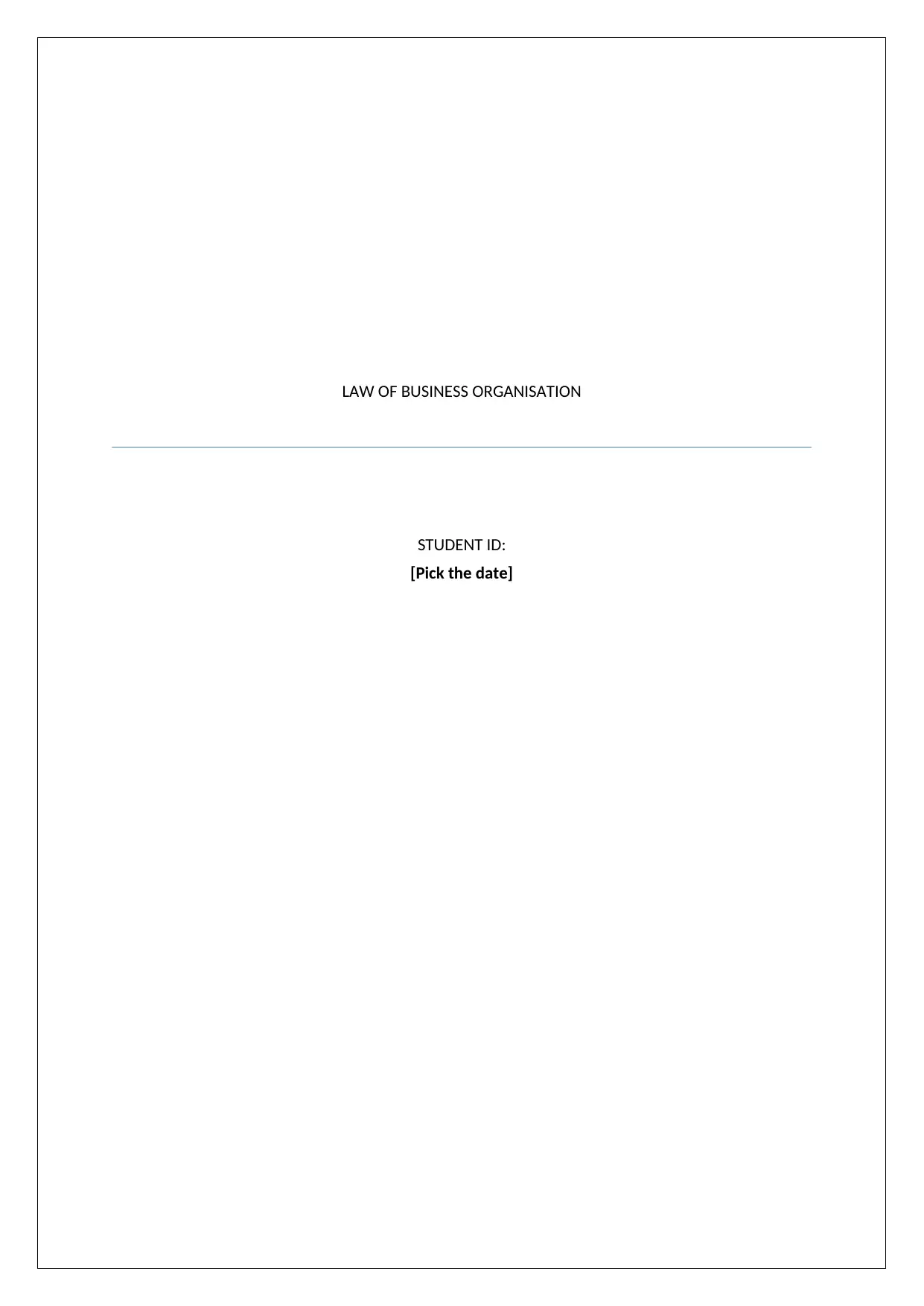
LAW OF BUSINESS ORGANISATION
STUDENT ID:
[Pick the date]
STUDENT ID:
[Pick the date]
Paraphrase This Document
Need a fresh take? Get an instant paraphrase of this document with our AI Paraphraser
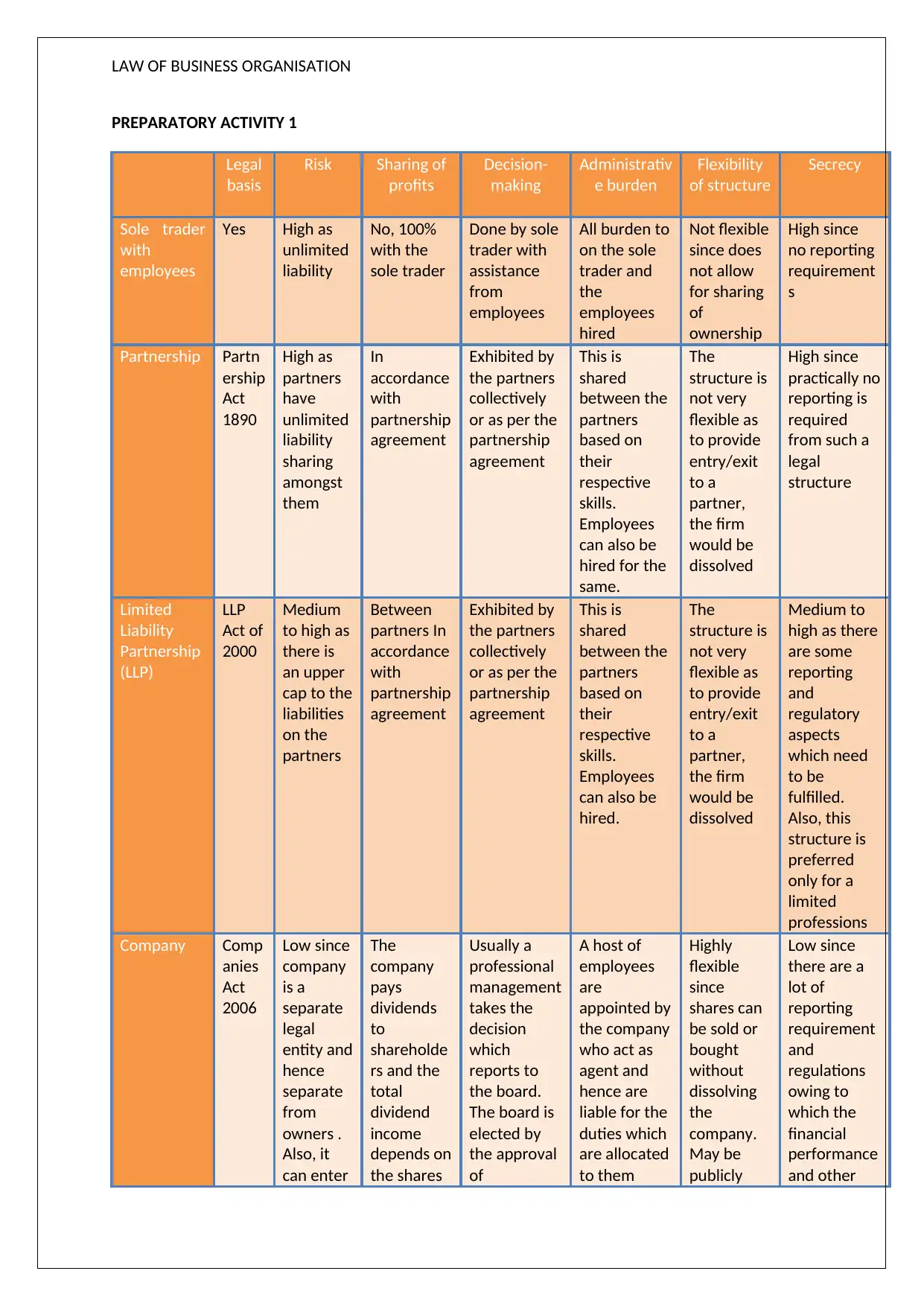
LAW OF BUSINESS ORGANISATION
PREPARATORY ACTIVITY 1
Legal
basis
Risk Sharing of
profits
Decision-
making
Administrativ
e burden
Flexibility
of structure
Secrecy
Sole trader
with
employees
Yes High as
unlimited
liability
No, 100%
with the
sole trader
Done by sole
trader with
assistance
from
employees
All burden to
on the sole
trader and
the
employees
hired
Not flexible
since does
not allow
for sharing
of
ownership
High since
no reporting
requirement
s
Partnership Partn
ership
Act
1890
High as
partners
have
unlimited
liability
sharing
amongst
them
In
accordance
with
partnership
agreement
Exhibited by
the partners
collectively
or as per the
partnership
agreement
This is
shared
between the
partners
based on
their
respective
skills.
Employees
can also be
hired for the
same.
The
structure is
not very
flexible as
to provide
entry/exit
to a
partner,
the firm
would be
dissolved
High since
practically no
reporting is
required
from such a
legal
structure
Limited
Liability
Partnership
(LLP)
LLP
Act of
2000
Medium
to high as
there is
an upper
cap to the
liabilities
on the
partners
Between
partners In
accordance
with
partnership
agreement
Exhibited by
the partners
collectively
or as per the
partnership
agreement
This is
shared
between the
partners
based on
their
respective
skills.
Employees
can also be
hired.
The
structure is
not very
flexible as
to provide
entry/exit
to a
partner,
the firm
would be
dissolved
Medium to
high as there
are some
reporting
and
regulatory
aspects
which need
to be
fulfilled.
Also, this
structure is
preferred
only for a
limited
professions
Company Comp
anies
Act
2006
Low since
company
is a
separate
legal
entity and
hence
separate
from
owners .
Also, it
can enter
The
company
pays
dividends
to
shareholde
rs and the
total
dividend
income
depends on
the shares
Usually a
professional
management
takes the
decision
which
reports to
the board.
The board is
elected by
the approval
of
A host of
employees
are
appointed by
the company
who act as
agent and
hence are
liable for the
duties which
are allocated
to them
Highly
flexible
since
shares can
be sold or
bought
without
dissolving
the
company.
May be
publicly
Low since
there are a
lot of
reporting
requirement
and
regulations
owing to
which the
financial
performance
and other
PREPARATORY ACTIVITY 1
Legal
basis
Risk Sharing of
profits
Decision-
making
Administrativ
e burden
Flexibility
of structure
Secrecy
Sole trader
with
employees
Yes High as
unlimited
liability
No, 100%
with the
sole trader
Done by sole
trader with
assistance
from
employees
All burden to
on the sole
trader and
the
employees
hired
Not flexible
since does
not allow
for sharing
of
ownership
High since
no reporting
requirement
s
Partnership Partn
ership
Act
1890
High as
partners
have
unlimited
liability
sharing
amongst
them
In
accordance
with
partnership
agreement
Exhibited by
the partners
collectively
or as per the
partnership
agreement
This is
shared
between the
partners
based on
their
respective
skills.
Employees
can also be
hired for the
same.
The
structure is
not very
flexible as
to provide
entry/exit
to a
partner,
the firm
would be
dissolved
High since
practically no
reporting is
required
from such a
legal
structure
Limited
Liability
Partnership
(LLP)
LLP
Act of
2000
Medium
to high as
there is
an upper
cap to the
liabilities
on the
partners
Between
partners In
accordance
with
partnership
agreement
Exhibited by
the partners
collectively
or as per the
partnership
agreement
This is
shared
between the
partners
based on
their
respective
skills.
Employees
can also be
hired.
The
structure is
not very
flexible as
to provide
entry/exit
to a
partner,
the firm
would be
dissolved
Medium to
high as there
are some
reporting
and
regulatory
aspects
which need
to be
fulfilled.
Also, this
structure is
preferred
only for a
limited
professions
Company Comp
anies
Act
2006
Low since
company
is a
separate
legal
entity and
hence
separate
from
owners .
Also, it
can enter
The
company
pays
dividends
to
shareholde
rs and the
total
dividend
income
depends on
the shares
Usually a
professional
management
takes the
decision
which
reports to
the board.
The board is
elected by
the approval
of
A host of
employees
are
appointed by
the company
who act as
agent and
hence are
liable for the
duties which
are allocated
to them
Highly
flexible
since
shares can
be sold or
bought
without
dissolving
the
company.
May be
publicly
Low since
there are a
lot of
reporting
requirement
and
regulations
owing to
which the
financial
performance
and other
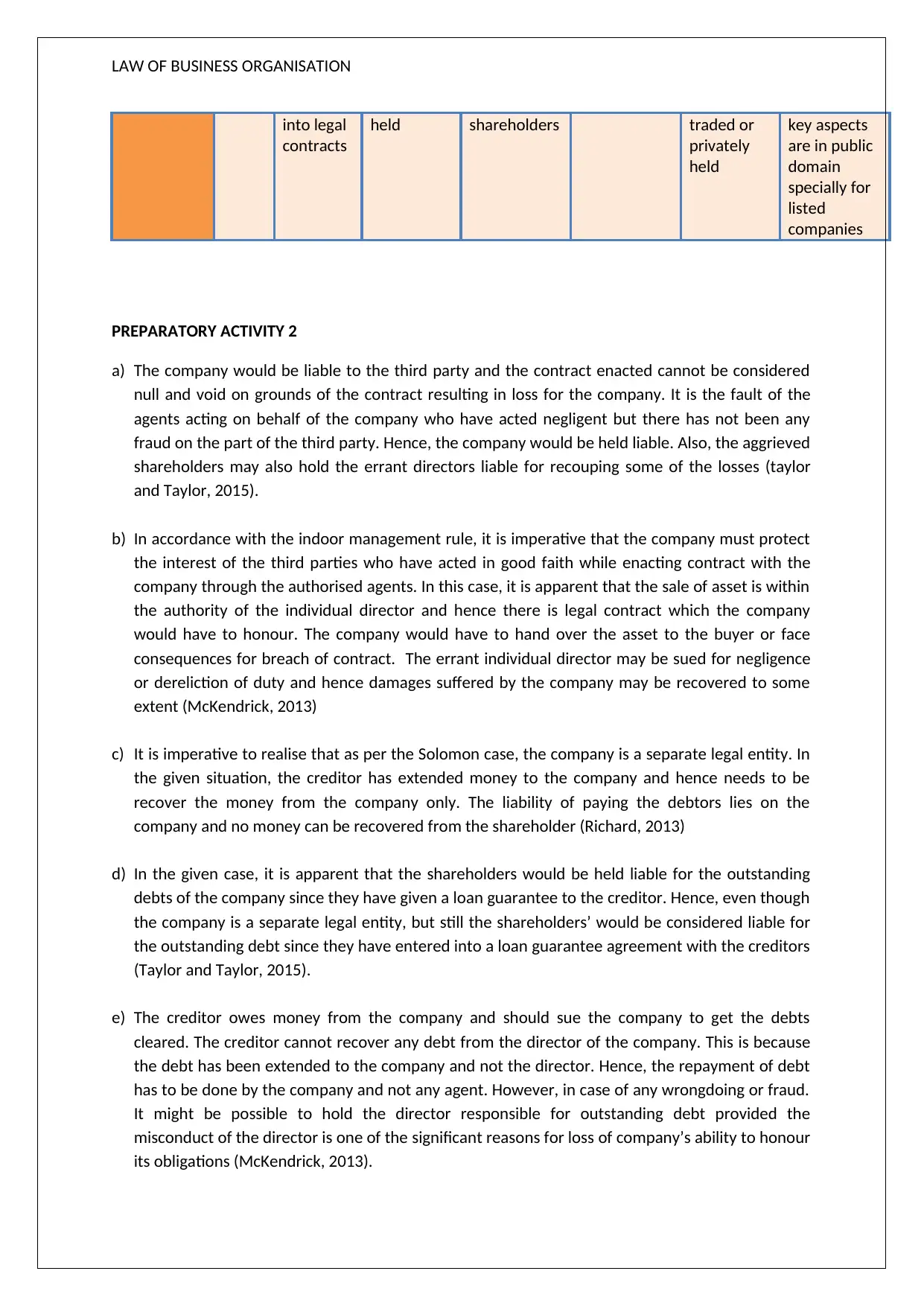
LAW OF BUSINESS ORGANISATION
into legal
contracts
held shareholders traded or
privately
held
key aspects
are in public
domain
specially for
listed
companies
PREPARATORY ACTIVITY 2
a) The company would be liable to the third party and the contract enacted cannot be considered
null and void on grounds of the contract resulting in loss for the company. It is the fault of the
agents acting on behalf of the company who have acted negligent but there has not been any
fraud on the part of the third party. Hence, the company would be held liable. Also, the aggrieved
shareholders may also hold the errant directors liable for recouping some of the losses (taylor
and Taylor, 2015).
b) In accordance with the indoor management rule, it is imperative that the company must protect
the interest of the third parties who have acted in good faith while enacting contract with the
company through the authorised agents. In this case, it is apparent that the sale of asset is within
the authority of the individual director and hence there is legal contract which the company
would have to honour. The company would have to hand over the asset to the buyer or face
consequences for breach of contract. The errant individual director may be sued for negligence
or dereliction of duty and hence damages suffered by the company may be recovered to some
extent (McKendrick, 2013)
c) It is imperative to realise that as per the Solomon case, the company is a separate legal entity. In
the given situation, the creditor has extended money to the company and hence needs to be
recover the money from the company only. The liability of paying the debtors lies on the
company and no money can be recovered from the shareholder (Richard, 2013)
d) In the given case, it is apparent that the shareholders would be held liable for the outstanding
debts of the company since they have given a loan guarantee to the creditor. Hence, even though
the company is a separate legal entity, but still the shareholders’ would be considered liable for
the outstanding debt since they have entered into a loan guarantee agreement with the creditors
(Taylor and Taylor, 2015).
e) The creditor owes money from the company and should sue the company to get the debts
cleared. The creditor cannot recover any debt from the director of the company. This is because
the debt has been extended to the company and not the director. Hence, the repayment of debt
has to be done by the company and not any agent. However, in case of any wrongdoing or fraud.
It might be possible to hold the director responsible for outstanding debt provided the
misconduct of the director is one of the significant reasons for loss of company’s ability to honour
its obligations (McKendrick, 2013).
into legal
contracts
held shareholders traded or
privately
held
key aspects
are in public
domain
specially for
listed
companies
PREPARATORY ACTIVITY 2
a) The company would be liable to the third party and the contract enacted cannot be considered
null and void on grounds of the contract resulting in loss for the company. It is the fault of the
agents acting on behalf of the company who have acted negligent but there has not been any
fraud on the part of the third party. Hence, the company would be held liable. Also, the aggrieved
shareholders may also hold the errant directors liable for recouping some of the losses (taylor
and Taylor, 2015).
b) In accordance with the indoor management rule, it is imperative that the company must protect
the interest of the third parties who have acted in good faith while enacting contract with the
company through the authorised agents. In this case, it is apparent that the sale of asset is within
the authority of the individual director and hence there is legal contract which the company
would have to honour. The company would have to hand over the asset to the buyer or face
consequences for breach of contract. The errant individual director may be sued for negligence
or dereliction of duty and hence damages suffered by the company may be recovered to some
extent (McKendrick, 2013)
c) It is imperative to realise that as per the Solomon case, the company is a separate legal entity. In
the given situation, the creditor has extended money to the company and hence needs to be
recover the money from the company only. The liability of paying the debtors lies on the
company and no money can be recovered from the shareholder (Richard, 2013)
d) In the given case, it is apparent that the shareholders would be held liable for the outstanding
debts of the company since they have given a loan guarantee to the creditor. Hence, even though
the company is a separate legal entity, but still the shareholders’ would be considered liable for
the outstanding debt since they have entered into a loan guarantee agreement with the creditors
(Taylor and Taylor, 2015).
e) The creditor owes money from the company and should sue the company to get the debts
cleared. The creditor cannot recover any debt from the director of the company. This is because
the debt has been extended to the company and not the director. Hence, the repayment of debt
has to be done by the company and not any agent. However, in case of any wrongdoing or fraud.
It might be possible to hold the director responsible for outstanding debt provided the
misconduct of the director is one of the significant reasons for loss of company’s ability to honour
its obligations (McKendrick, 2013).
⊘ This is a preview!⊘
Do you want full access?
Subscribe today to unlock all pages.

Trusted by 1+ million students worldwide
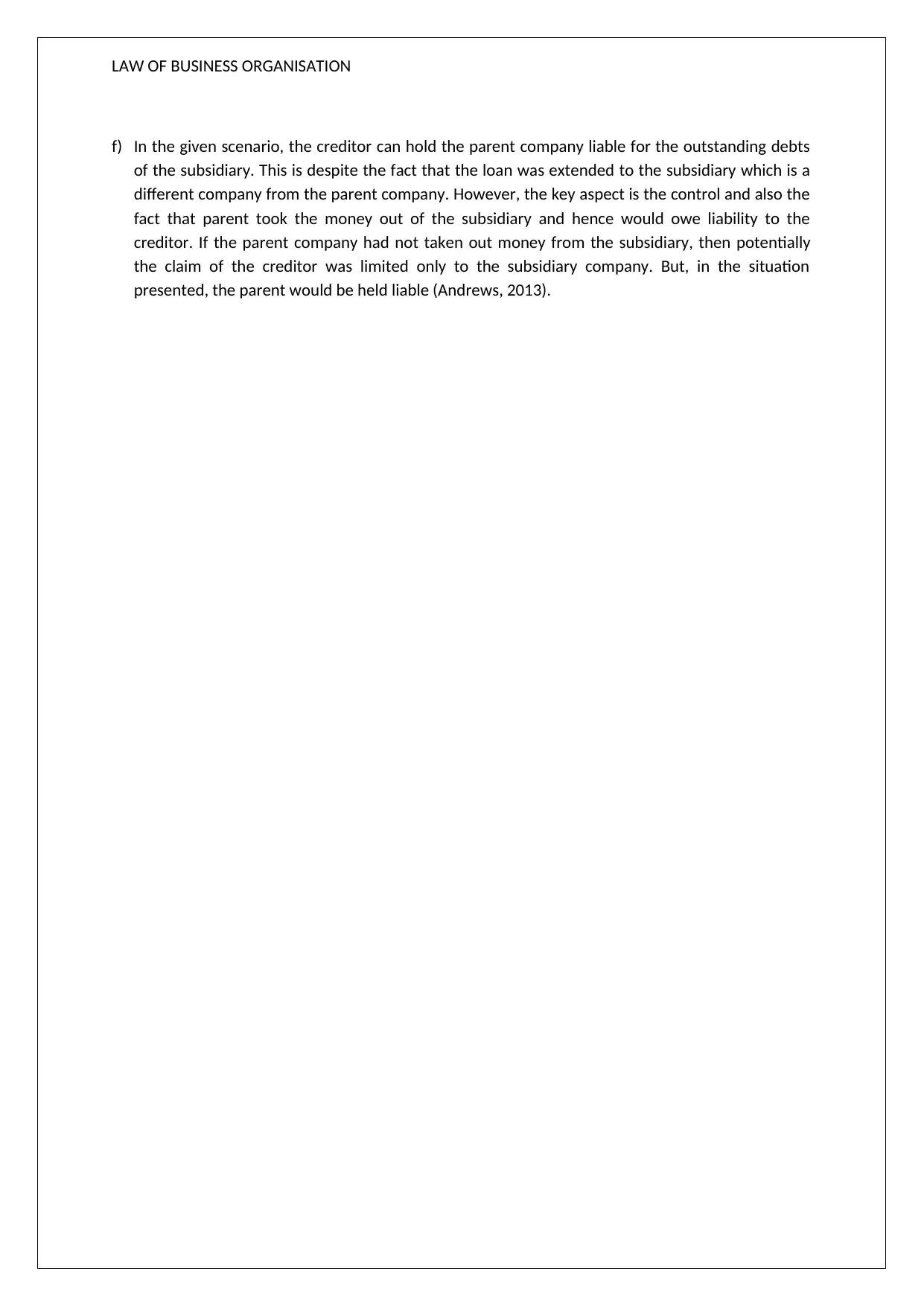
LAW OF BUSINESS ORGANISATION
f) In the given scenario, the creditor can hold the parent company liable for the outstanding debts
of the subsidiary. This is despite the fact that the loan was extended to the subsidiary which is a
different company from the parent company. However, the key aspect is the control and also the
fact that parent took the money out of the subsidiary and hence would owe liability to the
creditor. If the parent company had not taken out money from the subsidiary, then potentially
the claim of the creditor was limited only to the subsidiary company. But, in the situation
presented, the parent would be held liable (Andrews, 2013).
f) In the given scenario, the creditor can hold the parent company liable for the outstanding debts
of the subsidiary. This is despite the fact that the loan was extended to the subsidiary which is a
different company from the parent company. However, the key aspect is the control and also the
fact that parent took the money out of the subsidiary and hence would owe liability to the
creditor. If the parent company had not taken out money from the subsidiary, then potentially
the claim of the creditor was limited only to the subsidiary company. But, in the situation
presented, the parent would be held liable (Andrews, 2013).
Paraphrase This Document
Need a fresh take? Get an instant paraphrase of this document with our AI Paraphraser
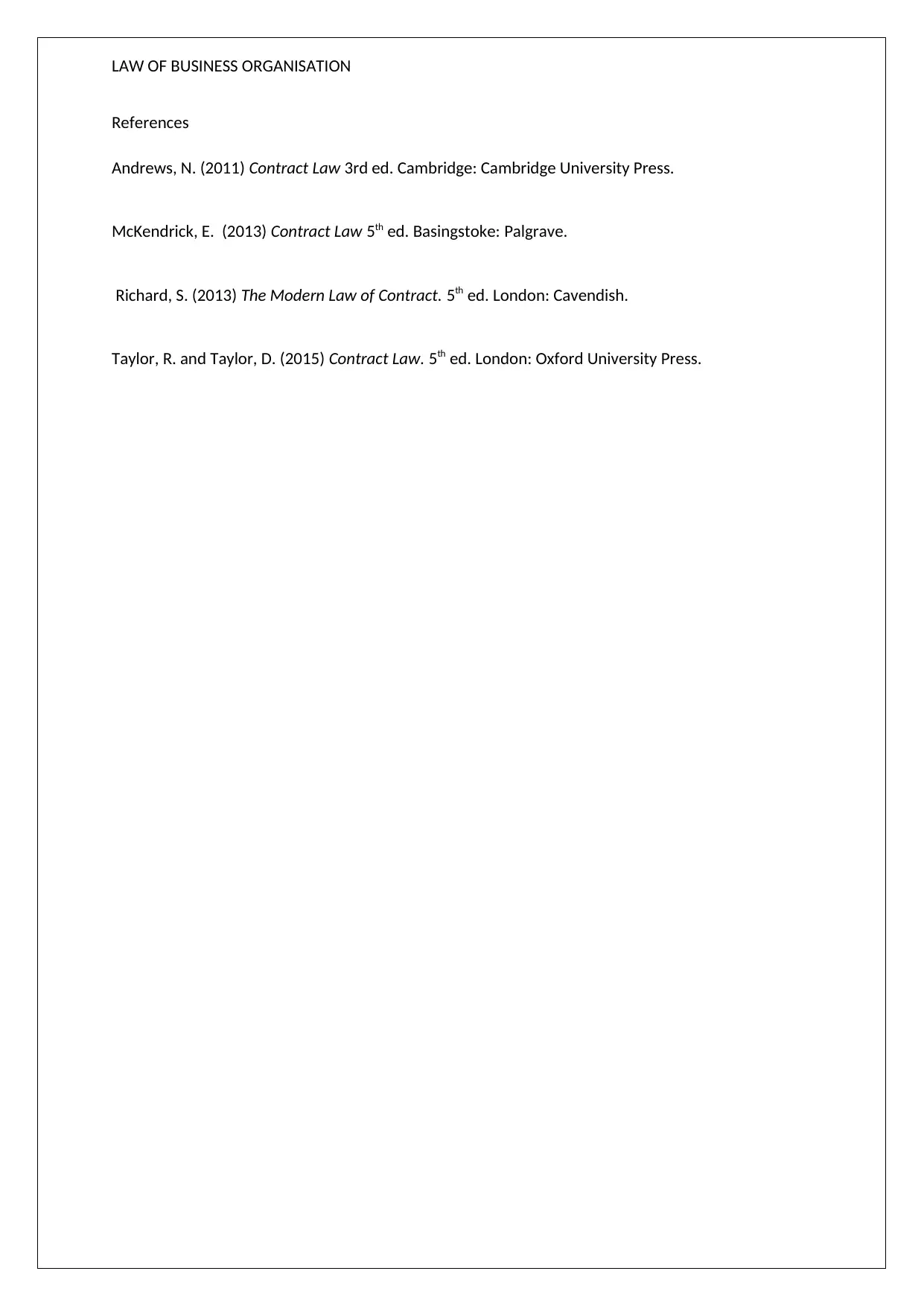
LAW OF BUSINESS ORGANISATION
References
Andrews, N. (2011) Contract Law 3rd ed. Cambridge: Cambridge University Press.
McKendrick, E. (2013) Contract Law 5th ed. Basingstoke: Palgrave.
Richard, S. (2013) The Modern Law of Contract. 5th ed. London: Cavendish.
Taylor, R. and Taylor, D. (2015) Contract Law. 5th ed. London: Oxford University Press.
References
Andrews, N. (2011) Contract Law 3rd ed. Cambridge: Cambridge University Press.
McKendrick, E. (2013) Contract Law 5th ed. Basingstoke: Palgrave.
Richard, S. (2013) The Modern Law of Contract. 5th ed. London: Cavendish.
Taylor, R. and Taylor, D. (2015) Contract Law. 5th ed. London: Oxford University Press.
1 out of 5
Related Documents
Your All-in-One AI-Powered Toolkit for Academic Success.
+13062052269
info@desklib.com
Available 24*7 on WhatsApp / Email
![[object Object]](/_next/static/media/star-bottom.7253800d.svg)
Unlock your academic potential
Copyright © 2020–2025 A2Z Services. All Rights Reserved. Developed and managed by ZUCOL.





